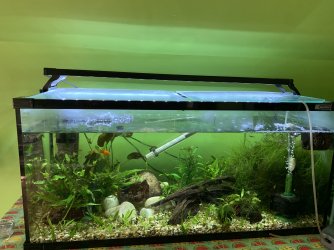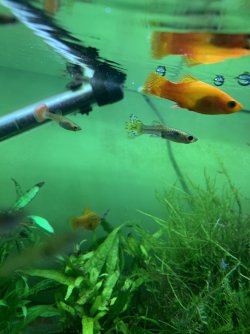Hi, I have had this problem for a while now but it seemed to have stopped but over the last week or two it has come back
Tank size: 130l
pH: 7.4 (tested normal ph and was dark blue 7.6 so tested high range and was 7.4)
ammonia:0
nitrite: 0
nitrate: 2.5-5
kH: don’t have a test
gH: don’t have a test
tank temp: 23.4 C
Fish Symptoms (include full description including lesion, color, location, fish behavior):
About 5 months ago (or more even) one of my platys got thin and died (stringy white poop and really thin) and then a few months went by and one of my other platys got thin and died.
I spoke to my local fish shop and they said to treat with esha 2000 and esha gdex (it didn’t seem to do anything)
About a month ago one of my adult platys got really thin all of a sudden (stringy poop) and so I QT her and treated her with NT labs anti fluke and wormer, it seemed to work and she got better so I put her back in my main tank.
And a few weeks ago one of my juvenile platys (medium size) got really thin and died and also some of my baby platys and then my platy which previously got better suddenly got really skinny and has now died.
Now all my guppies are getting thin and my last adult platy left has got stringy poop.
I would treat the whole tank with NT labs anti fluke and wormer again but I have amano shrimp and apparently it kills them (and I like my shrimp so I don’t want to kill them!!)
I don’t have a qt tank cycled at the moment so I can’t put any fish in there and I have a feeling it will be a whole tank treatment since i think it’s probably parasites.
I also have Esha NDX and it says that treats roundworms- is that callamnus? Because I haven’t seen any protruding red worms.
Do you think the ndx would work for this?
Volume and Frequency of water changes:
30-40% every 2 weeks (water changed yesterday)
Chemical Additives or Media in your tank:
Treated with esha 2000 and GDEX 1 or two weeks ago
Tank inhabitants: 4 adult guppies, 5-10 juvenile guppies, many baby guppies, 1 adult platy, 1 almost adult platy, 2 juvenile platys, 5ish 1 or 2 month old platys (I think a few have died)
5 amano shrimp.
I started out with just 5 guppies and 5 platys but they have had fry.
Recent additions to your tank (living or decoration): I did a tank change around yesterday as I had loads of plant seedlings (I know it was probably the wrong time to do that!!)
Exposure to chemicals: None except the medicine around a week ago but I don’t think thats what you mean my chemicals!
Digital photo (include if possible
hopefully you can give me some advice,
Thanks
Tank size: 130l
pH: 7.4 (tested normal ph and was dark blue 7.6 so tested high range and was 7.4)
ammonia:0
nitrite: 0
nitrate: 2.5-5
kH: don’t have a test
gH: don’t have a test
tank temp: 23.4 C
Fish Symptoms (include full description including lesion, color, location, fish behavior):
About 5 months ago (or more even) one of my platys got thin and died (stringy white poop and really thin) and then a few months went by and one of my other platys got thin and died.
I spoke to my local fish shop and they said to treat with esha 2000 and esha gdex (it didn’t seem to do anything)
About a month ago one of my adult platys got really thin all of a sudden (stringy poop) and so I QT her and treated her with NT labs anti fluke and wormer, it seemed to work and she got better so I put her back in my main tank.
And a few weeks ago one of my juvenile platys (medium size) got really thin and died and also some of my baby platys and then my platy which previously got better suddenly got really skinny and has now died.
Now all my guppies are getting thin and my last adult platy left has got stringy poop.
I would treat the whole tank with NT labs anti fluke and wormer again but I have amano shrimp and apparently it kills them (and I like my shrimp so I don’t want to kill them!!)
I don’t have a qt tank cycled at the moment so I can’t put any fish in there and I have a feeling it will be a whole tank treatment since i think it’s probably parasites.
I also have Esha NDX and it says that treats roundworms- is that callamnus? Because I haven’t seen any protruding red worms.
Do you think the ndx would work for this?
Volume and Frequency of water changes:
30-40% every 2 weeks (water changed yesterday)
Chemical Additives or Media in your tank:
Treated with esha 2000 and GDEX 1 or two weeks ago
Tank inhabitants: 4 adult guppies, 5-10 juvenile guppies, many baby guppies, 1 adult platy, 1 almost adult platy, 2 juvenile platys, 5ish 1 or 2 month old platys (I think a few have died)
5 amano shrimp.
I started out with just 5 guppies and 5 platys but they have had fry.
Recent additions to your tank (living or decoration): I did a tank change around yesterday as I had loads of plant seedlings (I know it was probably the wrong time to do that!!)
Exposure to chemicals: None except the medicine around a week ago but I don’t think thats what you mean my chemicals!
Digital photo (include if possible
hopefully you can give me some advice,
Thanks



